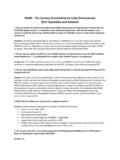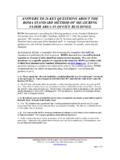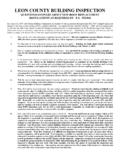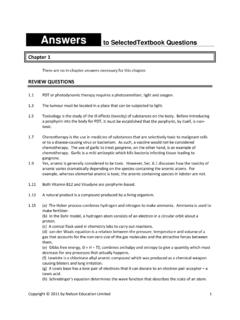Transcription of Multifamily Mailbox: 4350 - HUD.gov / U.S. …
1 Updated August 2007 final Multifamily mailbox : REV-1 Summary of Questions Following is the summary of questions on Handbook Rev-1 requirements collected from the online Multifamily Housing Programs mailbox . The summary of questions has been categorized by topic. INDEX 1. Civil Rights and Nondiscrimination ..2 2. Marketing Requirements ..3 3. Projects other than Section 202/811 ..4 Project Staff/Police and Security Personnel ..4 Income Limits ..5 4. Section 202 and Section 811 5. Live-in Aides ..8 6. Remaining Family Member.
2 9 7. Income Targeting ..10 8. Waiting Lists ..10 9. Selection of Tenants ..11 Applicant Interviews ..12 Tenant Selection Plans ..12 Social Security Numbers ..13 Resident Rights Brochure ..13 10. Occupancy Standards ..14 11. Citizenship ..16 12. Screening and Eviction ..18 13. Income ..19 14. Assets ..21 15. Deductions/Allowances ..23 16. Minimum Rent ..26 17. Utility 18. Verification ..27 19. Annual and Interim Recertifications ..29 20. Lease and Lease Attachments ..32 Leases ..32 House Other 21.
3 Gross Rent Changes ..36 22. Termination of Assistance and Fraud ..37 23. Late Fees and Other Charges ..38 24. Security Deposits ..39 25. Tenant Rental Assistance Certification System (TRACS) ..40 26. File Retention ..42 27. General Information/Miscellaneous ..43 1 Updated August 2007 CIVIL RIGHTS AND NONDISCRIMINATION 1. question : Are owners required to post their TTY number on their project sign?
4 Answer: When an owner lists a telephone number, he/she must also list the TTY number. If the telephone number is on the sign, then the TTY must also be listed (Chapter 2, Paragraph 2-29 ). 2. question : Can a management agent override a board of a co-op if the board does not want to make reasonable accommodations for persons with disabilities? Answer: No. The co-op board represents the ownership entity of the development. However, the co-op board will be putting the project at risk by not providing reasonable accommodations to persons with disabilities.
5 The Fair Housing Act of 1988, as amended, requires housing providers to provide reasonable accommodations to persons with disabilities. See Chapter 2, Section 3, Subsection 4 for more information on reasonable accommodation. The management agent and HUD have a responsibility to notify the co-op board in writing of actions that do not meet HUD statutory requirements. 3. question : For an in-place resident who asks for a reasonable accommodation (transfer to another unit), can the owner ask for verification from a health care professional that the accommodation is necessary (not inquiring about the nature of the disability, but the need to move into an accessible unit)?
6 Answer: Yes. Chapter 3, Paragraph 3-28 B provides guidance for the owner to verify disability to determine eligibility for a project, preference, or allowance, and identify the need for an accessible unit or reasonable accommodation. 4. question : We have a subsidized 221(d)(4) project for families that has House Rules limiting the weight of dogs to no more than 15 pounds. One of the residents has a disabled daughter. The daughter's healthcare provider has recommended in writing that she get a dog for emotional therapy to help her condition.
7 Will this resident's dog have to comply with the project's weight restriction? Answer: No. As stated in Chapter 6, Paragraph 6-10 , an owner must not apply pet rules for common household pets to assistance animals (also referred to as service animals , support animals or therapy animals ) and their owners. However, the animal must meet all standard tenant lease requirements ( , noise, nuisance, security of other tenants). The owner can adopt appropriate criteria for assistance animals.
8 See Chapter 2, Paragraph 2-44 for guidance on assistance animals as a reasonable accommodation. If the owner chooses to allow common household pets at the family project he/she can establish pet rules for these animals in accordance with the requirements in paragraph 6-10. See the Glossary for the definition of Common Household Pet. *Denotes a revision to the question or Answer ** Denotes a revision to the handbook reference only. 2 Updated August 2007 5.
9 question : The Handbook states in Exhibit 2-3 that "owners must provide the information specified in Chapter 2, Paragraph 2-29 in all written communications with the public. Owners may use this exhibit as guidance in providing this information. Exhibit 2-3 refers to the Section 504 notification of nondiscrimination on the basis of disability status. Does the Section 504 notice also have to be included on a housing provider's website when that provider lists his/her apartment community's features on the Internet ( , website)?
10 Answer: Yes. The Section 504 notice must also be included on a housing provider's website when that provider lists its apartment community's features on its website. 6. question : What is the difference between a service animal, a pet, and a companion animal? Answer: An assistance animal (also referred to as a service animal, support animal, or therapy animal ) is defined as an animal that works, provides assistance, performs tasks for the benefit of a person with a disability, or provides emotional support that alleviates one or more identified symptoms or effects of a person s disability (Chapter 2, Paragraph 2-44).















